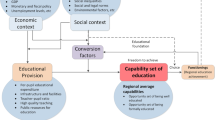Abstract
This paper analyzes the effect of increasing human-capital mobility—i.e. student and labor mobility—on net tax revenues when revenue-maximizing governments compete for human capital by means of income tax rates and amenities offered to students (positive expenditure) or rather tuition fees (negative expenditure). An increase in labor mobility implies neither an intensified tax competition nor an erosion of revenues. In fact, the equilibrium tax rate even increases in labor mobility. Amenities offered to students are non-monotonically related to labor mobility; overall, net revenues increase with labor mobility. An increase in student mobility, however, erodes revenues, mainly due to intensified tax competition. A concurrent cutback in expenditures mitigates this erosion but cannot fully prevent it.
Similar content being viewed by others
References
Andersson, F., & Konrad, K. (2003a). Human capital investment and globalization in extortionary states. Journal of Public Economics, 87, 1539–1555.
Andersson, F., & Konrad, K. (2003b). Globalization and risky human-capital investment. International Tax and Public Finance, 10, 211–228.
Baruch, Y., Budhwar, P., & Khatri, N. (2007). Brain drain: inclination to stay abroad after studies. Journal of World Business, 42, 99–112.
Bayindir-Upmann, T., & Ziad, A. (2005). Existence of equilibria in a basic tax-competition model. Regional Science and Urban Economics, 35, 1–22.
Boadway, R., Marceau, N., & Marchand, M. (1996). Investment in education and the time inconsistency of redistributive tax policy. Economica, 63, 171–189.
Beckmann, M., & Papageorgiou, Y. (1989). Heterogeneous tastes and residential location. Journal of Regional Science, 29, 317–323.
Boneva, B., & Frieze, I. (2001). Toward a concept of a migrant personality. Journal of Social Issues, 57, 477–491.
Buettner, T., & Schwager, R. (2004). Regionale Verteilungseffekte der Hochschulfinanzierung und ihre Konsequenzen. In W. Franz, H. J. Ramser, & M. Stadler (Eds.), Wirtschaftswissenschaftliches Seminar Ottobeuren: Vol. 33. Bildung (pp. 251–278). Tuebingen.
Del Rey, E. (2001). Economic integration and public provision of education. Empirica, 28, 203–218.
Demange, G., Fenge, R., & Uebelmesser, S. (2008a). The provision of higher education in a global world—analysis and policy implications. CESifo Economic Studies, 54, 248–276.
Demange, G., Fenge, R., & Uebelmesser, S. (2008b). Financing higher education and labor mobility (CESifo Working Paper 2362).
Dreher, A., & Poutvaara, P. (2005). Student flows and migration: an empirical analysis (IZA Discussion Paper 1612).
Finn, M. (2003). Stay rates of foreign doctorate recipients from US universities. Oak Ridge Institute for Science and Education, Oak Ridge.
Haupt, A., & Janeba, E. (2009). Education, redistribution, and the threat of brain drain. International Tax and Public Finance, 16, 1–24.
Haupt, A., & Krieger, T. (2009). The role of mobility in tax and subsidy competition (CESifo Working Paper 2555).
Haupt, A., & Peters, W. (2003). Voting on public pensions with hands and feet. Economics of Governance, 4, 57–80.
Henseler, M., & Plesch, J. (2009). How can scholarship institutions foster the return of foreign students? Journal of Economics and Statistics, 229, 382–409.
Justman, M., & Thisse, J.-F. (1997). Implications of the mobility of skilled labor for local public funding of higher education. Economics Letters, 55, 409–412.
Justman, M., & Thisse, J.-F. (2000). Local public funding of higher education when skilled labor is imperfectly mobile. International Tax and Public Finance, 7, 247–258.
Kemnitz, A. (2007). Educational federalism and the quality effects of tuition fees (Dresden Discussion Paper in Economics 08/07).
Konrad, K. (1995). Fiscal federalism and intergenerational redistribution. FinanzArchiv/Public Finance Analysis, 52, 166–181.
Krieger, T., & Lange, T. (2010). Education policy and tax competition with imperfect student and labor mobility. Available at SSRN: http://ssrn.com/abstract=1133436.
Lange, T. (2009). Public funding of higher education when students and skilled workers are mobile. FinanzArchiv/Public Finance Analysis, 65, 178–199.
Lowell, L., Bump, M., & Martin, S. (2007). Foreign students coming to America: the impact of policy, procedures, and economic competition (ISIM Georgetown University, Project Summary Report).
Mansoorian, A., & Myers, G. (1993). Attachment to home and efficient purchases of population in a fiscal externality economy. Journal of Public Economics, 52, 117–132.
Mechtenberg, L., & Strausz, R. (2008). The Bologna process: how student mobility affects multi-cultural skills and educational quality. International Tax and Public Finance, 15, 109–130.
OECD (2001). Trends in international migration—SOPEMI 2001. OECD, Paris.
OECD (2008). Education at a Glance. OECD, Paris.
Poutvaara, P. (2000). Education, mobility of labour and tax competition. International Tax and Public Finance, 7, 699–719.
Poutvaara, P. (2001). Alternative tax constitutions and risky education in a federation. Regional Science and Urban Economics, 31, 355–377.
Poutvaara, P. (2004). Educating Europe: should public education be financed with graduate taxes or income-contingent loans? CESifo Economic Studies, 50, 663–684.
Poutvaara, P. (2008). Public and private education in an integrated Europe: studying to migrate and teaching to stay? The Scandinavian Journal of Economics, 110, 591–608.
Poutvaara, P., & Kanniainen, V. (2000). Why invest in your neighbor? Social contract on educational investment. International Tax and Public Finance, 7, 547–562.
Rosenzweig, M. (2006). Higher education and international migration in Asia: brain circulation. Paper prepared for the Regional Bank Conference on Development Economics in Beijing, Higher Education and Development, January 2007.
Tremblay, K. (2005). Academic mobility and immigration. Journal of Studies in International Education, 9, 196–228.
Wildasin, D. (2000). Labor-market integration, investment in risky human capital, and fiscal competition. American Economic Review, 90, 73–95.
Author information
Authors and Affiliations
Corresponding author
Additional information
The authors would like to thank Panu Poutvaara, Bjarne Strøm, Bernd Genser, Dirk Schindler, Reinhold Schnabel, two anonymous referees, and the editor for their most valuable comments and suggestions. The paper also benefited from discussions at the EPCS meeting in Jena, the IIPF congress in Maastricht, the joint EEA/ESEM congress in Milan, the conference of the German Economic Association in Graz, the BevOeA in Bamberg, at CES in Munich and seminars at the Universities of Konstanz and Paderborn. Thomas Lange gratefully acknowledges financial support from the German Research Foundation DFG (research group “Heterogeneous Labor”) and Fritz Thyssen Stiftung.
Rights and permissions
About this article
Cite this article
Krieger, T., Lange, T. Education policy and tax competition with imperfect student and labor mobility. Int Tax Public Finance 17, 587–606 (2010). https://doi.org/10.1007/s10797-010-9129-9
Published:
Issue Date:
DOI: https://doi.org/10.1007/s10797-010-9129-9




